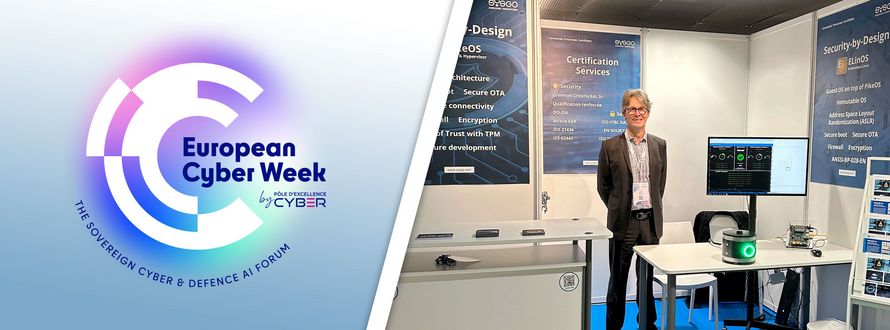Last week, SYSGO had the privilege to participate in the 10th edition of the European Cyber Week (ECW), held from November 17–20, 2025, at the Couvent des Jacobins in Rennes, France. As one of Europe’s leading forums on cyber-defense, sovereign AI, and digital trust, ECW brought together over 8,000 participants, 140 exhibitors, and more than 350 speakers across high-level plenaries, workshops, and networking events.
For our team, it was a unique opportunity to demonstrate cutting-edge embedded security technology, engage in challenging technical conversations, and deepen our collaborations within the European cyber ecosystem.
Why ECW matters for SYSGO
European Cyber Week is more than a business-development venue: It is a strategic rendezvous for public-sector, defense, and industrial actors to shape the future of European cyber sovereignty.
As a company that provides high-assurance operating systems and security-certified embedded software, SYSGO’s participation aligns strongly with ECW’s mission. We came with a clear message: Embedded systems are critical surfaces for cyber-defense, and they must be built on a foundation of strong separation, integrity, and certification.
The Security Demonstrator
At Booth 103, our team showcased an advanced security demonstrator featuring:
- PikeOS, our separation-kernel RTOS, running on a Xilinx KRIA board
- An immutable Linux environment using ELinOS, representing an unmodifiable, integrity-preserving guest
- A bifurcated architecture: trusted and untrusted domains, separated by a firewall under PikeOS control
- A LiDAR sensor emulation to simulate intrusion detection; during “threat states,” the firewall dynamically constrains communication between domains
Technically, this demonstrator illustrated real-time enforcement of security policies, based on the separation kernel architecture of PikeOS. Because PikeOS partitions are isolated at the kernel level, we can enforce strict information flow control — even under critical threat scenarios. Crucially, the firewall wasn't just a static policy gate: It adapted to the sensor-driven threat model, exemplifying how embedded systems can enforce dynamic, context-sensitive security.
One of the most compelling points for us: The system is designed to meet Common Criteria EAL 5+, making it suitable for high-assurance use cases in defense, aerospace, or industrial critical infrastructure.
Highlights from the Floor
Throughout the event, our booth drew a diverse crowd: cybersecurity researchers, systems integrators, defense officials, and embedded-systems engineers. Many visitors were drawn in by the LiDAR/sensor-driven threat simulation — it’s a concrete, tangible way to show how zero-trust and separation kernel principles apply to cyber-physical systems.
Because our demonstrator is not just conceptual but operational, we were able to engage in deep technical dialogues:
- Certification questions: Several attendees from defense and regulated industries asked about our certification roadmap — how far we are in achieving or maintaining Common Criteria and which levels
- Real-time constraints: System integrators asked about latencies introduced by the firewall, how the data paths are managed, and whether worst-case execution times (WCET) are affected
- Update and patch mechanisms: People were very interested in how we handle updates in such a locked-down architecture while preserving immutability and integrity
Certification as Differentiator
High-assurance certification (e.g., Common Criteria) is not just a “nice to have” for ECW visitors — several organizations explicitly demand it. For SYSGO, our certification story is not just marketing: it is a cornerstone of our competitive edge.
The event confirmed that building a secure European sovereign stack requires collaboration: integration partners, system integrators, defense primes, and research projects are vital. ECW is a fertile ground for nurturing these partnerships.
Final Thoughts
From where we stand, European Cyber Week 2025 was a resounding success. It was a place to influence and to shape the conversation around embedded, high-assurance systems and their centrality for European digital sovereignty.
For SYSGO, the event underscored that real-time, separation-kernel-based architectures are not niche anymore — they are mission-critical. The enthusiasm from visitors, the technical depth of discussions, and the quality of connections made were all very encouraging.
We left Rennes energized, with new leads, potential partners, and a clear sense of direction. In a rapidly evolving cyber-defense landscape, we believe strongly that trusted, high-assurance embedded systems will play a key role — and ECW was a milestone on that journey.

